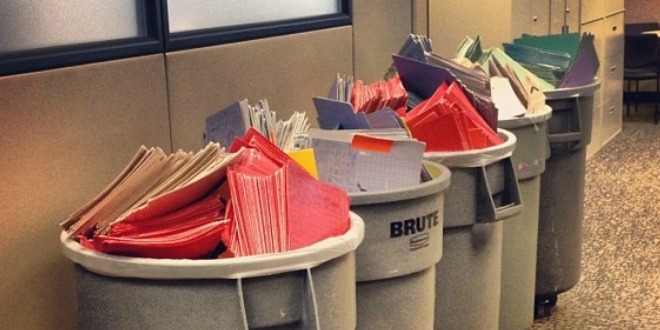There is a sentence I have noticed that appears more and more often in emails, official documents, and on websites. Please consider the environment before printing this page [1], and every time I see this I get slightly irritated. This is a phenomenon that can be tied to the increasing attention for sustainability, and the result is often a guilt trip of some sort about your personal use of paper, and the apparently disastrous effect it has on the environment [2]. There is this unspoken opinion that printing documents on paper in any form is terribly destructive, and the only way to save the environment is to do everything from the screen of a computer from now on. But is this statement true? It suggests two things: one, that paper is completely unsustainable and the only reason we are not yet completely paperless is lack of effort. Two, using a computer is much better for the environment.
So first I researched the paperless office, and several points jumped out at me. The first is that this actual ‘paperless office’ trend is not new. While there has been a resurgence due to climate change, the actual debate has been going on for over thirty years, ever since the first computers appeared in offices [3]. Actual numbers show that we are nowhere close to reaching this goal, and in fact use of paper increases up to 25% in offices every year. One of the reason is that, as studies show, reading comprehension is simply much higher from paper. People might produce information on computers, but consume it from paper. Going paperless simply doesn’t really work. The Myth of the Paperless office is a book produced by Abigail Sellen and Richard Harper. They try to deconstruct this idea, by analyzing the way people use paper, and what they could use paper and digital techniques for. As a conclusion they point out that a paperless office is not realistic, and anything more extreme than a paperlight office will simply not work [4].
The next point this ultinatum raised was: digital media is a sustainable alternative to paper. Computers have become so normal in daily life, we do not really question how they are powered. We plug the charger into the outlet, and from there we spare no thought to it. While waste paper can be seen in bins, and stacked up on desks, computers create invisible waste in other ways. Digital technology is manufactured using embodied energy, also known as grey energy and produces e-waste [2]. These waste streams do exist, and using the computer a lot does increase them, which does cause damage to the environment.
In the end, working completely digitally is not the black and white solution these email requests make it out to be. We cannot function without paper in offices, and we shouldn’t have to. We should simply be aware of the fact that both of these methods produce waste in different ways, and try to use both of them sparingly, and in the right situation. Sustainability is not an easy catchphrase, and cannot be achieved in ‘5 Steps to a (Nearly) Paperless Office’ [5]. Sustainability is a struggle and takes consideration and careful choices every day, and manifests in many different ways. So maybe the next time I see an important document I need to read carefully, I might simply print it out, and then turn off my computer and my phone, and just read.
[1] Carli, D. (2010). Going Paperless: Not as Green as You May Think Retrieved December 5th, 2015, from http://www.greenbiz.com/blog/2010/04/14/going-paperless-not-green-and-tree-friendly-you-think
[2] Carli, D. (not dated.). Print vs. Digital Media: False Dilemmas and Forced Choices. New York: Institute for Sustainable Communication.
[3] Milliken, G. (2015). The Paperless office: 30 year old pipe dream? Retrieved December 5th, , 2015, from http://www.wired.com/insights/2014/01/paperless-office-30-year-old-pipe-dream/
[4] McElhearn, K. (2012). Review of the Myth of the Paperless Office Retrieved December 5th, , 2015, from http://www.techsoc.com/paperless.htm
[5] Harrison, K. (2013). 5 Steps To (Nearly) Paperless Office Retrieved December 5th, , 2015, from http://www.forbes.com/sites/kateharrison/2013/04/19/5-steps-to-a-nearly-paperless-office/
[Image] Milliken, G. (2015). The Paperless office: 30 year old pipe dream? Retrieved December 5th, , 2015, from http://www.wired.com/insights/2014/01/paperless-office-30-year-old-pipe-dream/
